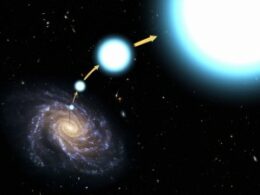Vast cloud of glowing gas discovered near Whirlpool Galaxy
Astronomers have discovered a vast cloud of glowing gas close to one of the most famous spiral galaxies in the night sky. The previously undetected cloud is more than 80,000 light-years long and 24,000 light-years wide. It lies about 105,000 light-years north of Messier 51 (M51), the Whirlpool Galaxy.
It is not seen in visible light but revealed itself in hydrogen alpha light, when imaged by the 24-inch (60cm) Burrell Schmidt Telescope at Kitt Peak, Arizona.
M51 was discovered by comet-hunter Charles Messier in 1773. He included in a catalogue of fuzzy objects he compiled that might be mistaken for comets. It is bright enough to be seen as a blur in binoculars or small telescopes, shining at magnitude 8.4.
The first person to notice its spiral shape was the Third Earl of Rosse, William Parsons, in 1845, using his 72-inch (1.8 meter) reflecting telescope at Birr Castle in Ireland. At the time, it was the largest telescope in the world.
Related: Supernova flares in Whirlpool Galaxy
An international team led by Dr Aaron Watkins, of Case Western Reserve University (CWRU), Cleveland, Ohio, discovered the nearby cloud of ionized gas during observations made over several moonless nights in March, April, and May, 2015.
They found that its motion through space confirms that it is linked to M51, also known as NGC 5194, which lies around 23 million light-years away in the constellation of Canes Venatici, the Hunting Dogs.
M51 is already famous for being connected to a bright blob that is a second, interacting galaxy, known as NGC 5195.
Watkins’ team found that there is no star formation occurring within the newly discovered gas cloud. They suggest that it was probably expelled from the inner regions of the M51 system due to tidal forces or stellar winds.
It might be glowing because it has been baked by radiation from M51’s active galactic nucleus (AGN), which houses a supermassive black hole. That would make it a close example of a feature called Hanny’s Voorwerp, a glowing gas cloud spotted by Dutch teacher Hanny van Arkel near the galaxy IC 2497, about 650 million light-years away.
In a preprint of their paper about the discovery, on Arxiv.org, the discovery team say: “The Cloud’s size and structure — and, perhaps most importantly, the proximity of the M51 system — provide a unique opportunity to study the detailed effects of feedback and ionization on the circumgalactic environments of galaxies.
“The local universe contains very few known examples of extended diffuse emission sources like the Cloud; each new example provides a wealth of new information about tidal interactions, feedback processes, and the mutual interaction between galaxies and their environment.
“In particular, if the Cloud is a fossil nebula or echo of strong AGN activity in M51, it would be the most nearby example of a rapidly fading AGN, and also represent a new and critical piece to our understanding of the iconic M51 system.”
A preprint of the research paper, Discovery of a vast ionized gas cloud in the M51 system, can be read here. It will be published in The Astrophysical Journal Letters.
Related: Tidal forces kicked stars out of our Milky Way galaxy
★ Keep up with space news and observing tips. Click here to sign up for alerts to our latest reports. No spam ever – we promise!

